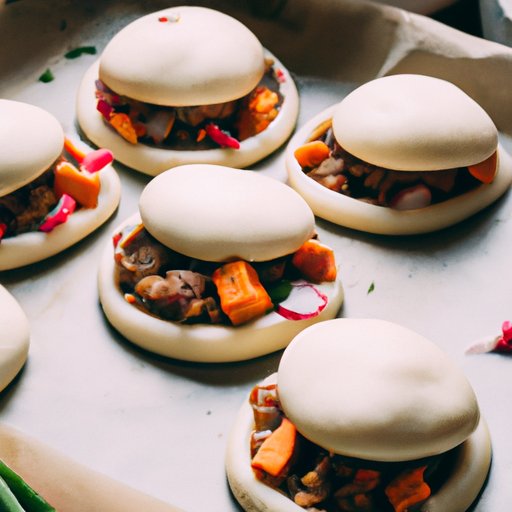
I. Introduction
If you’re new to the world of Asian cuisine, you may be wondering what all the fuss is about bao buns. These fluffy, steamed buns have made their way from their traditional origins in China to become a popular street food and restaurant staple around the world. But if you’re following a gluten-free diet, you might be concerned about whether or not you can enjoy this trendy treat. In this article, we’ll explore everything you need to know about bao buns and their gluten-free options.
II. Everything You Need to Know about Bao Buns and Their Gluten-Free Options
Before we dive into the details of gluten-free bao buns, let’s start with the basics. Gluten is a type of protein found in wheat, barley, rye, and other grains. For people with celiac disease or gluten sensitivity, consuming gluten can cause a range of symptoms, from digestive issues to skin problems and beyond. As a result, more and more people are adopting gluten-free diets not just out of necessity but as a lifestyle choice.
When it comes to gluten-free bao buns, the good news is that there are plenty of options available. Many recipes and restaurants now offer gluten-free versions of this classic dish, using alternative flours and other ingredients that don’t contain gluten.
Ingredients used in gluten-free bao bun preparation can include tapioca starch, rice flour, sweet potato starch, potato starch, and cornstarch. These flours and starches are all gluten-free and can produce a similar texture to traditional wheat flour. Additionally, many fillings commonly used in bao buns, such as pork belly, chicken, tofu, and vegetables, are all gluten-free as well.
III. Gluten-Free Bao Buns: Are They Worth the Hype?
As gluten-free diets continue to gain popularity, so do gluten-free food options. But are gluten-free bao buns really worth the hype? The answer is yes – and no. On the one hand, if you have a gluten sensitivity or celiac disease, gluten-free bao buns offer a tasty way to enjoy a popular Asian dish without sacrificing your health. However, gluten-free bao buns may not be as flavorful or have the same mouthfeel as traditional bao buns made with wheat flour.
Also, gluten-free bao buns may be more expensive than traditional bao buns due to the cost of alternative flours and ingredients. Nevertheless, if you’re willing to pay a bit more for a gluten-free option, the benefits can be worth it.
One potential downside to be aware of is that not all restaurants or stores offer gluten-free bao buns, and cross-contamination during preparation or cooking is always a risk. That’s why many people who follow a gluten-free diet choose to make their own bao buns at home. This way, they have full control over the ingredients and can ensure that there’s no risk of cross-contamination.
IV. Our Favorite Gluten-Free Bao Bun Recipes
If you’re looking to make your own gluten-free bao buns, there are plenty of recipes available online. Here are a few of our favorites:
– Traditional Gluten-Free Bao Buns: This recipe uses a mix of rice flour, potato starch, and tapioca flour to create a light, fluffy bun that’s perfect for stuffing with your favorite fillings.
– Paleo Bao Buns: This recipe uses coconut flour and almond flour in place of wheat flour, making it a great option for people who follow a paleo or grain-free diet. The recipe also includes a savory pork filling that’s sure to satisfy.
– Vegan Bao Buns: This recipe swaps out traditional pork belly for a hearty cauliflower and mushroom filling, making it a good choice for vegans or anyone looking for a plant-based option.
No matter which recipe you choose, be sure to follow the instructions closely and take your time. Making bao buns can be a bit of a labor of love, but the end result is well worth the effort!
V. A Gluten-Free Guide to Eating Bao Buns in Restaurants
If you’re hesitant to make your own bao buns at home, you can still enjoy them when dining out. Here are some tips for navigating menus and communicating with restaurant staff:
– Do your research ahead of time. Look up restaurants in your area that offer gluten-free bao buns, and read reviews from other customers to get an idea of how well the restaurant handles gluten-free requests.
– Be upfront with your server about your gluten-free needs. Ask if the restaurant offers gluten-free bao buns, and if not, whether there are any other gluten-free options available.
– Ask about ingredients and preparation. Make sure your server is aware of your concerns regarding cross-contamination, and ask if the kitchen can prepare your bao buns separately from other gluten-containing dishes.
VI. From Steaming to Serving: A Comprehensive Guide to Making Gluten-Free Bao Buns at Home
If you’re ready to take on the challenge of making gluten-free bao buns yourself, here’s a step-by-step guide to get you started:
– Mix up your dough. Combine your gluten-free flour blend with yeast, sugar, salt, and warm water, and knead until you have a smooth, elastic dough.
– Let your dough rest. Cover the dough with a damp cloth and let it rise until it’s doubled in size.
– Shape your buns. Divide your dough into small pieces and roll them out into circles. Place your filling in the center and gather the edges together, pinching them closed.
– Steam your bao buns. Place your bao buns on a steamer basket or in a bamboo steamer, and steam for about 10-15 minutes, or until cooked through.
VII. Conclusion
In conclusion, bao buns can be a delicious addition to any gluten-free diet, whether you’re making them yourself or enjoying them at a restaurant. With plenty of recipes and fillings to choose from, there’s no shortage of options when it comes to gluten-free bao buns.




